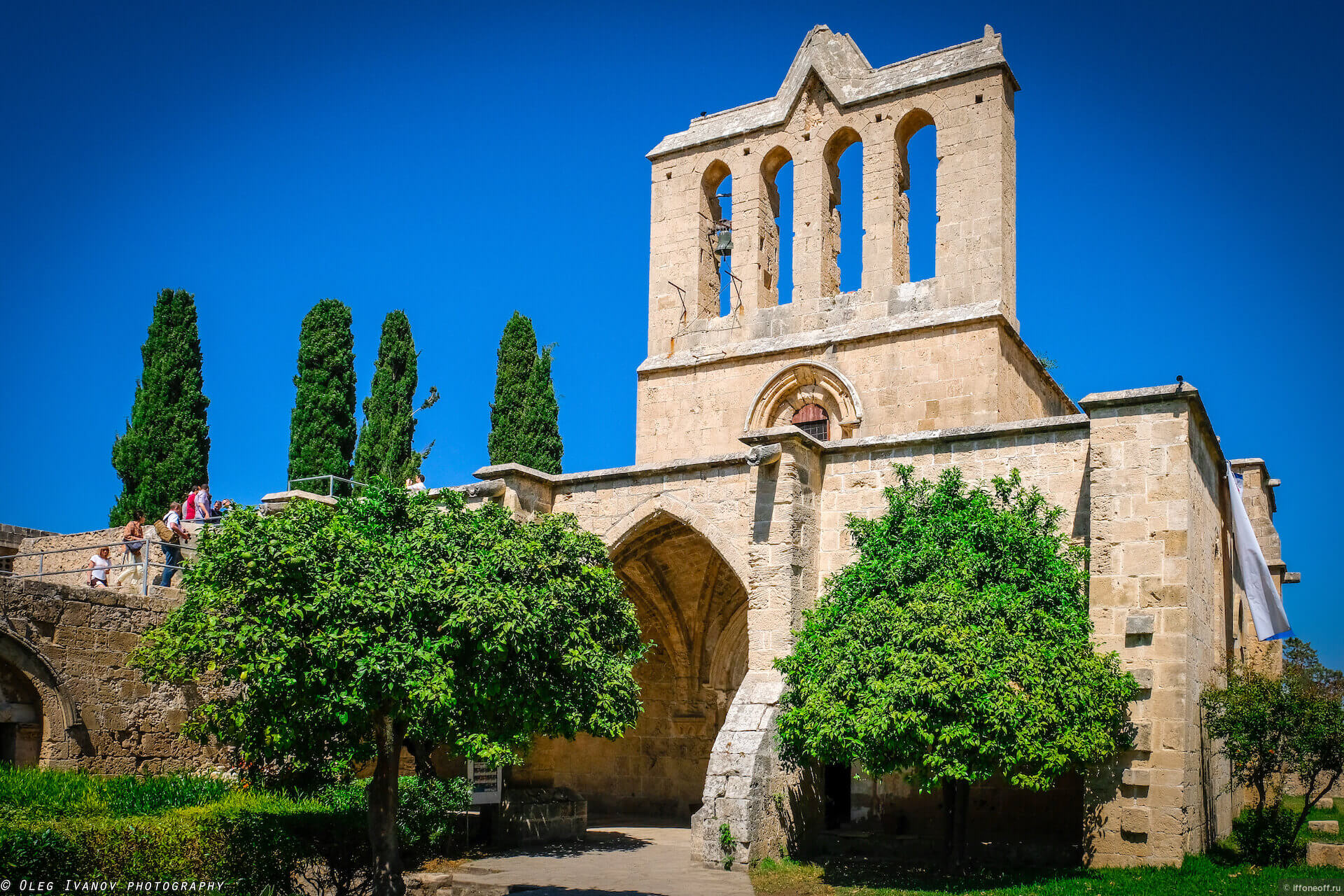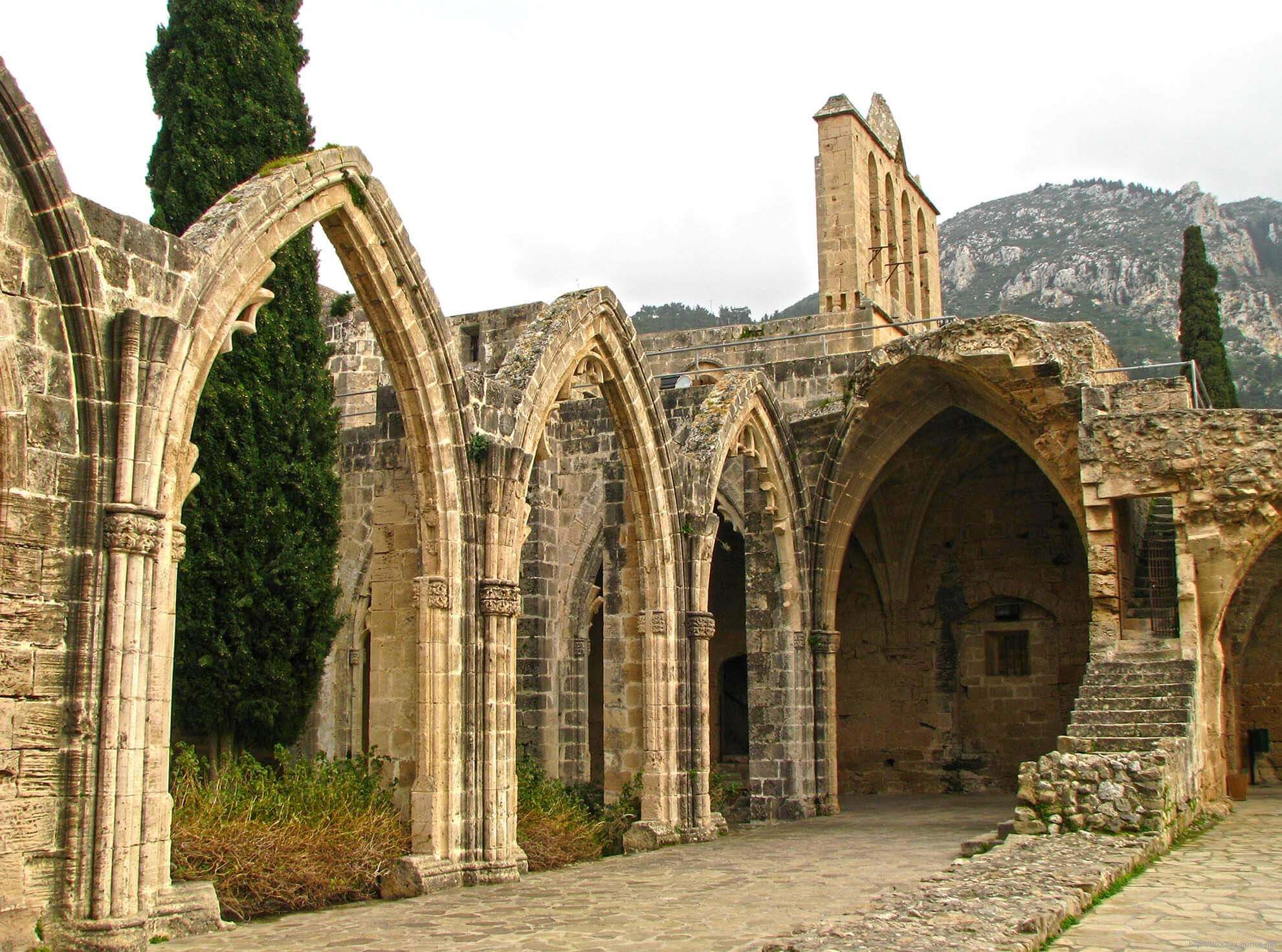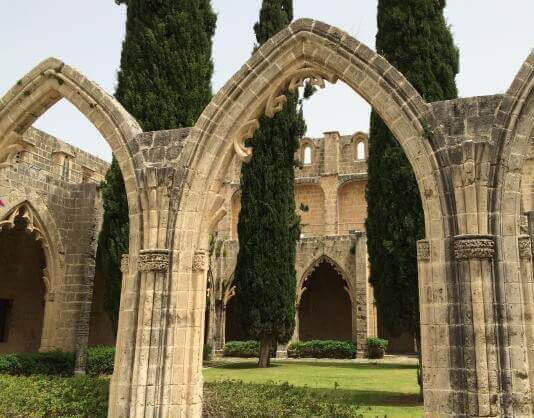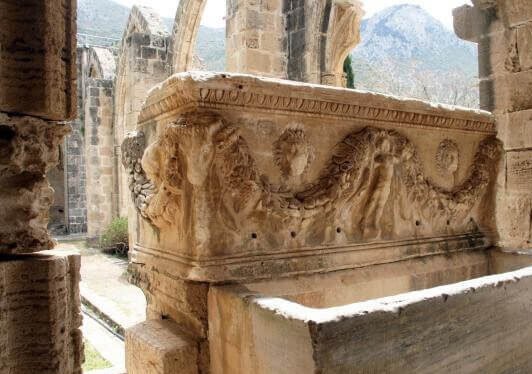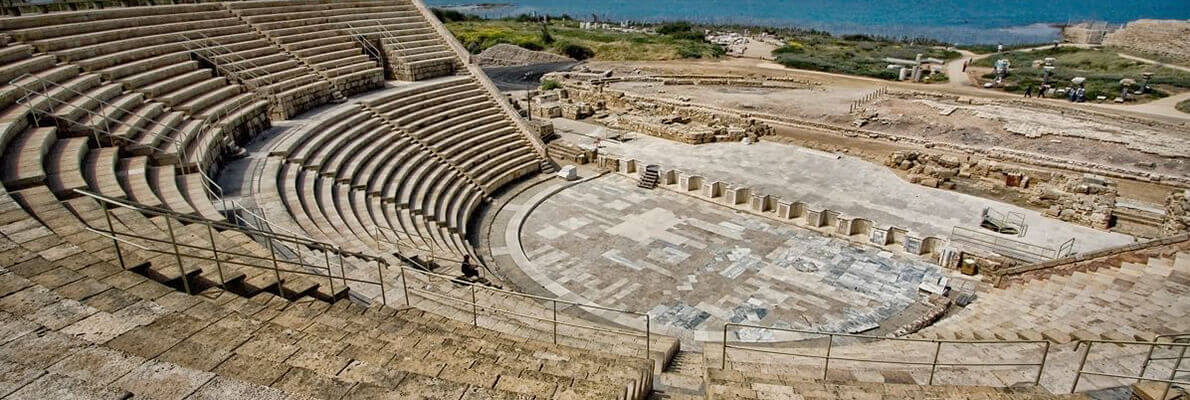While vacationing in Kyrenia or being in this city of northern cyprus on a tourist visit, do not deny yourself the pleasure of visiting the beautiful monument of northern french gothic, which perfectly complements the picturesque landscape of the foothills of the Beshparmak range.
История Аббатства Беллапаис
Bellapais Abbey, which is also known by the names "Abbey of the Beautiful World", "White Abbey" began to be built in the 12th century. The first monks to settle in the monastery were representatives of the Augustinian Order. Most of the abbey was built under the kings Hugh III and Hugh IV.
The White Abbey got its name from the fact that the monks wore white robes with white hoods, which saved them from the hot Cypriot sun. The Abbey reached its peak of power in the 13th century, when 600 gold coins and a piece of the Life-Giving Cross were transferred to the shrine by the will of the knight Roger Normand. The Catholic monastery began to get upset, pilgrims from all over the world reached out to it – it was a great honor for any Catholic to visit the shrine. The monastery was famous for the fact that the monks who lived in it led an ascetic lifestyle and strictly adhered to all canons. They practically did not communicate with each other, lived in their cells, and were completely devoted to the faith. Even in winter, the monastic cells were not heated, the monks slept without warm blankets. Of course, this did not apply to the high-ranking guests of the complex who came here, among whom were members of the royal family of Lusignan.
Unfortunately, the Abbey's heyday did not last long. Already in the 14th century, Genoese appeared in Kyrenia, who could not pass by this place. The monastery was looted. Along with the lost relics, supplies of provisions and all sorts of goods, many monks lost their morals and spirituality. The monastery became a place of debauchery. The monks retreated from the canon of celibacy, began to live in cells with mistresses, and practiced polygamy.
Unfortunately, the Abbey's heyday did not last long. Already in the 14th century, Genoese appeared in Kyrenia, who could not pass by this place. The monastery was looted. Along with the lost relics, supplies of provisions and all sorts of goods, many monks lost their morals and spirituality. The monastery became a place of debauchery. The monks retreated from the canon of celibacy, began to live in cells with mistresses, and practiced polygamy.
After the Genoese, the abbey passed into the hands of the Turks, who expelled the monks and gave the monastery to the Orthodox Church of Cyprus. Later, the abbey was under the rule of the British, who used it to house a military unit. After the Second World War, the abbey was used as a tourist attraction.
After the Genoese, the abbey passed into the hands of the Turks, who expelled the monks and gave the monastery to the Orthodox Church of Cyprus. Later, the abbey was under the rule of the British, who used it to house a military unit. After the Second World War, the abbey was used as a tourist attraction.
Legends
The history of the Abbey is steeped in legends, one of which concerns the punishment of monks who deviated from the faith after the attack on the monastery of the Genoese. Legend has it that one day the abbot of the monastery was walking past the cells and heard lively sounds outside the doors. Once inside, he was shocked to find two monks with their mistresses. For those who longed for intimacy, a severe punishment was prepared, which separated the guilty forever. The sinners were buried in the courtyard of the abbey, each in a different corner. Cypress trees were planted at the burial site, which every year stretch up and up, but never touch.
The history of the Abbey is steeped in legends, one of which concerns the punishment of monks who deviated from the faith after the attack on the monastery of the Genoese. Legend has it that one day the abbot of the monastery was walking past the cells and heard lively sounds outside the doors. Once inside, he was shocked to find two monks with their mistresses. For those who longed for intimacy, a severe punishment was prepared, which separated the guilty forever. The sinners were buried in the courtyard of the abbey, each in a different corner. Cypress trees were planted at the burial site, which every year stretch up and up, but never touch.
The Architecture Of Bellapais Abbey
Architecture lovers will definitely enjoy wandering through the majestic halls of the abbey. The best preserved of the entire complex is the Abbey Church with its beautiful Gothic arches.
A huge room designed for refectory-refectory-is located on the first floor and has a size of 27 by 38 meters. During the period when the abbey was under the rule of the British, the soldiers used this room as a shooting gallery – you can even see bullet marks on the walls.
At the entrance to the refectory are richly decorated sarcophagi brought from Salamis. Their age dates back to the 2nd century AD. Sarcophagi were used as washbasins for washing hands before meals.
Those who wish can go down to the basement of the Abbey under the refectory. The spacious basement was used as a warehouse. Here it was possible to place huge food supplies and for a long time to exist independently in the event of a natural disaster or war.
Walking around the premises of the monastery, you can see many artifacts. the rooms impress with their acoustics, high vaulted walls and beautiful design. from the second floor of the refelectorium, you can enjoy beautiful views of the island, the mountains, the city of kyrenia and the azure sea.
Architecture lovers will definitely enjoy wandering through the majestic halls of the abbey. The best preserved of the entire complex is the Abbey Church with its beautiful Gothic arches.
A huge room designed for refectory-refectory-is located on the first floor and has a size of 27 by 38 meters. During the period when the abbey was under the rule of the British, the soldiers used this room as a shooting gallery – you can even see bullet marks on the walls.
At the entrance to the refectory are richly decorated sarcophagi brought from Salamis. Their age dates back to the 2nd century AD. Sarcophagi were used as washbasins for washing hands before meals.
Those who wish can go down to the basement of the Abbey under the refectory. The spacious basement was used as a warehouse. Here it was possible to place huge food supplies and for a long time to exist independently in the event of a natural disaster or war.
Walking around the premises of the monastery, you can see many artifacts. the rooms impress with their acoustics, high vaulted walls and beautiful design. from the second floor of the refelectorium, you can enjoy beautiful views of the island, the mountains, the city of kyrenia and the azure sea.
It will be interesting to walk through the courtyard of the abbey, surrounded on all sides by beautiful Gothic arches. Nearby is a heavily destroyed part of the monastery, which was previously a two-story building. On the first floor there was a meeting room, on the second-the cells of the monks.
The Abbey today
There are no services in the abbey or church these days. But music festivals are held, which are very popular. And they take place in a spacious refectory room with stunning acoustics.
Unfortunately, at one time, the local residents of the village of bellapais themselves contributed to the destruction of the shrine, dragging materials from here for the construction of their homes.
There are cafes near the abbey where you can have a hearty lunch. Entrance to the territory of the attraction is paid and costs 3 euros per person. Parking near the abbey is also paid.
There are no services in the abbey or church these days. But music festivals are held, which are very popular. And they take place in a spacious refectory room with stunning acoustics.
Unfortunately, at one time, the local residents of the village of bellapais themselves contributed to the destruction of the shrine, dragging materials from here for the construction of their homes.
There are cafes near the abbey where you can have a hearty lunch. Entrance to the territory of the attraction is paid and costs 3 euros per person. Parking near the abbey is also paid.
What to see next
If you still have the desire and energy to see something else after the abbey, stay for a while in the village of Bellapais — there are several interesting places here.
For example, in the village there is still a house that was built and lived in by lawrence durrell, a famous english writer. one of his works is the novel "bitter lemons" / bitter lemons. in this novel, the village itself and the events that took place here at that time are very colorfully described. Today, the writer's house stands on the street that bears the name of his novel — Bitter Lemons-but other people live in this house.
There is also a Tree of Idleness in the village of Bellapais, also described in Darrell's book. Today it is a favorite place for photos. It is believed that a person sitting in the shade of this tree becomes absolutely unfit for any work. Since the villagers often sit under this tree, it is believed that there are more idlers in Bellapais than anywhere else on the island, and they live to a great old age, because they do not overwork themselves much in their whole life. If you want to check whether the Tree of Idleness can somehow affect you-just sit under it for a few minutes.
If you still have the desire and energy to see something else after the abbey, stay for a while in the village of Bellapais — there are several interesting places here.
For example, in the village there is still a house that was built and lived in by lawrence durrell, a famous english writer. one of his works is the novel "bitter lemons" / bitter lemons. in this novel, the village itself and the events that took place here at that time are very colorfully described. Today, the writer's house stands on the street that bears the name of his novel — Bitter Lemons-but other people live in this house.
There is also a Tree of Idleness in the village of Bellapais, also described in Darrell's book. Today it is a favorite place for photos. It is believed that a person sitting in the shade of this tree becomes absolutely unfit for any work. Since the villagers often sit under this tree, it is believed that there are more idlers in Bellapais than anywhere else on the island, and they live to a great old age, because they do not overwork themselves much in their whole life. If you want to check whether the Tree of Idleness can somehow affect you-just sit under it for a few minutes.
How to get to Bellapais Abbey
You can get to Bellapais Abbey by taxi, rental car or as part of a tour group by bus. A taxi ride from Kyrenia costs 8-10 euros and takes no more than 15 minutes.
If you go from Nicosia by car, then you need to move towards Kyrenia, before the port turn right and follow the signs, pass the village of Bellapais and stop at the parking lot.
In the afternoon, there are not many visitors to the monastery, so if you are not afraid of the heat and want to walk around the complex, take a lot of beautiful pictures, you can plan a visit to the abbey at the specified time.
You can get to Bellapais Abbey by taxi, rental car or as part of a tour group by bus. A taxi ride from Kyrenia costs 8-10 euros and takes no more than 15 minutes.
If you go from Nicosia by car, then you need to move towards Kyrenia, before the port turn right and follow the signs, pass the village of Bellapais and stop at the parking lot.
In the afternoon, there are not many visitors to the monastery, so if you are not afraid of the heat and want to walk around the complex, take a lot of beautiful pictures, you can plan a visit to the abbey at the specified time.


